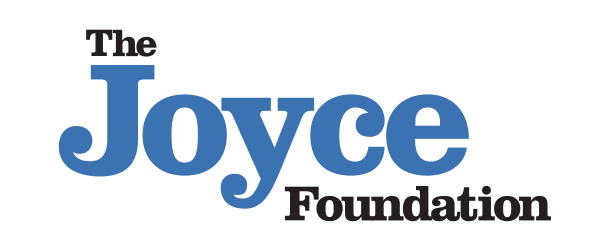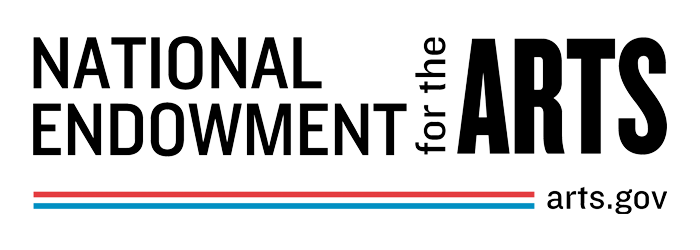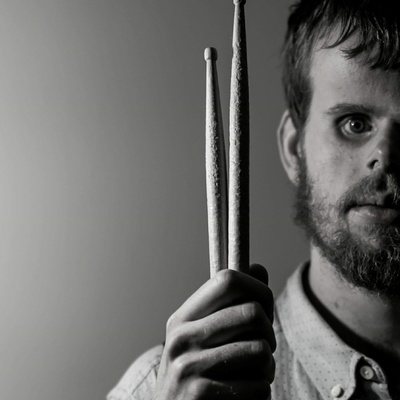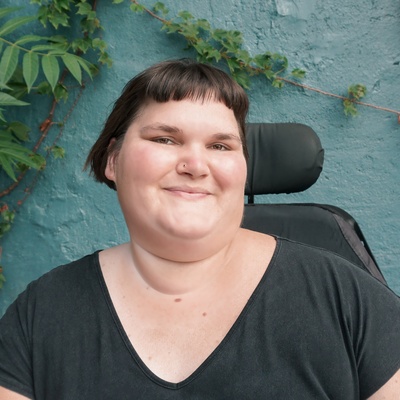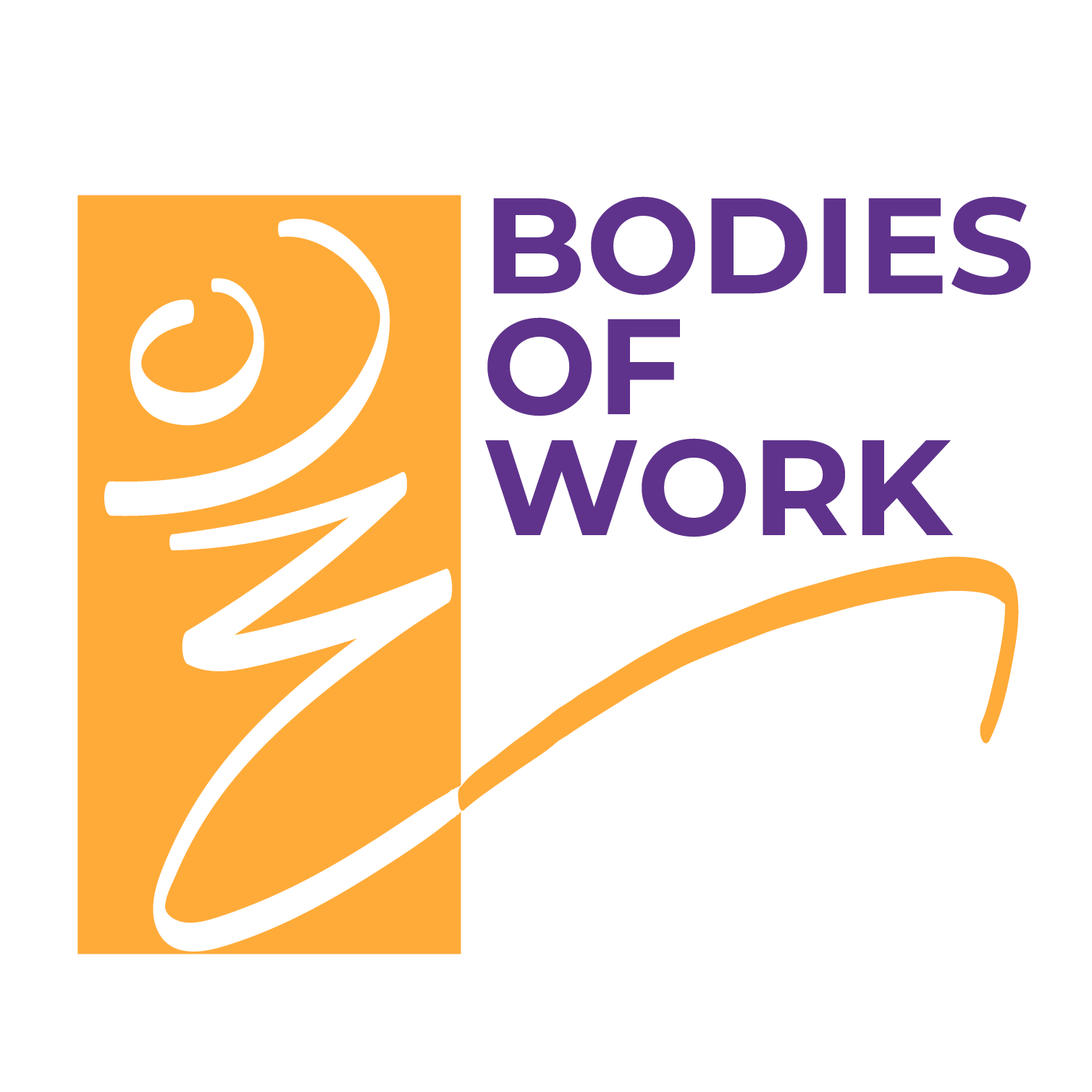Rhythm and Humor as Resistance
Fall 2023
Playwright and teaching artist Arlene Malinowski interviews drummer Tommy Carroll and media maker Kennedy Healy about music, media, and art as vehicles for disability culture and advocacy.
This is a transcript of the closed captions from the video conversation.
Arlene Malinowski: Hi, my name is Arlene Malinowski and I'm a playwright, actor, and teaching artist who makes autobiographical work that looks at the intersection of Disability Culture in the world at large. I'm excited to be here today with two artists, Tommy Carroll and Kennedy Healy, who recently participated in the 3Arts/Bodies of Work Residency Program.
As a fellow alum of that program myself, I'll be leading a conversation with them about their work, their experiences in the residency, and the way they situate themselves within the Disability Culture community. This conversation is part of a series called the Disability Culture Leadership Initiative led by 3Arts in partnership with Bodies of Work.
Special thanks to the Mayor's Office for People with Disabilities including Commissioner Rachel Arfa and the Central West Community Center here in Chicago which is one of the outposts operated by the Mayor's Office and where we're filming today.
Tommy Carroll is a drummer, composer, and beat maker who draws on dance, music, and improvisation to create a soundtrack for a more inclusive world. Kennedy Healy is a self-described fat, queer, crip media maker whose multi-disciplinary practice focuses on disability, accessibility, care, abolition, sexuality, and representation. Thank you both for being here with us today.
To get us started, in your own words, can you take a minute to describe your art, and not only what you make but why you make it. Tommy, why don't we start with you.
Tommy Carroll: I think, broadly speaking, I'm very interested in the wide, wide world of rhythm and just all of its various possibilities.
Calculated Discomfort UIC Concert ExcerptTommy Carroll: Everybody has a rhythm to them, socially, you know. They don't necessarily have to be a musician. I'm very interested in when you put different rhythms, whether we're literally talking musically or the rhythms of people's ways of socializing—both on and off the bandstand—and seeing how that can reflect the world or even improve the world. Because I am totally blind, I think I'm particularly drawn to that because a lot of the way I navigate through the world is by sensing the rhythms of various things happening around me like cars and traffic and when to cross and stuff like that.
Kennedy Healy: So I describe myself as a writer and media maker. I'm the founder of Crip Crap, which is a disability media company. I'm really interested in creating work that's for disabled people, or work that puts disabled people back in the center.
Section 504 - 2022 Easterseals Disability Film Challenge EntryKennedy Healy: Our tagline is "media about disability, by and for disabled people," and I get a lot of questions about why that is. I feel like the fact that that's a question sort of answers itself. Why wouldn't disabled people get media catered to us, rather than a one-hour workshop, kind of handholding a non-disabled audience to bring everyone into crip culture, and disability humor and experience in a really raw way? I think it's like a quicker educational opportunity.
Arlene Malinowski: I love that. Tell me what's important to you about your work.
Kennedy Healy: I grew up in Nebraska in the '90s and early 2000s, and I didn't see a lot of other disabled people. LIke, disability was fairly hidden, especially in the media. There wasn't a lot of narrative around a social model of disability or disability as a culture or community. So, I think that draws me in. And I think during the pandemic, the way we were talked about, but not to as much, and how people misunderstood the disabled experience in this ongoing time, also kind of shifted me toward media.
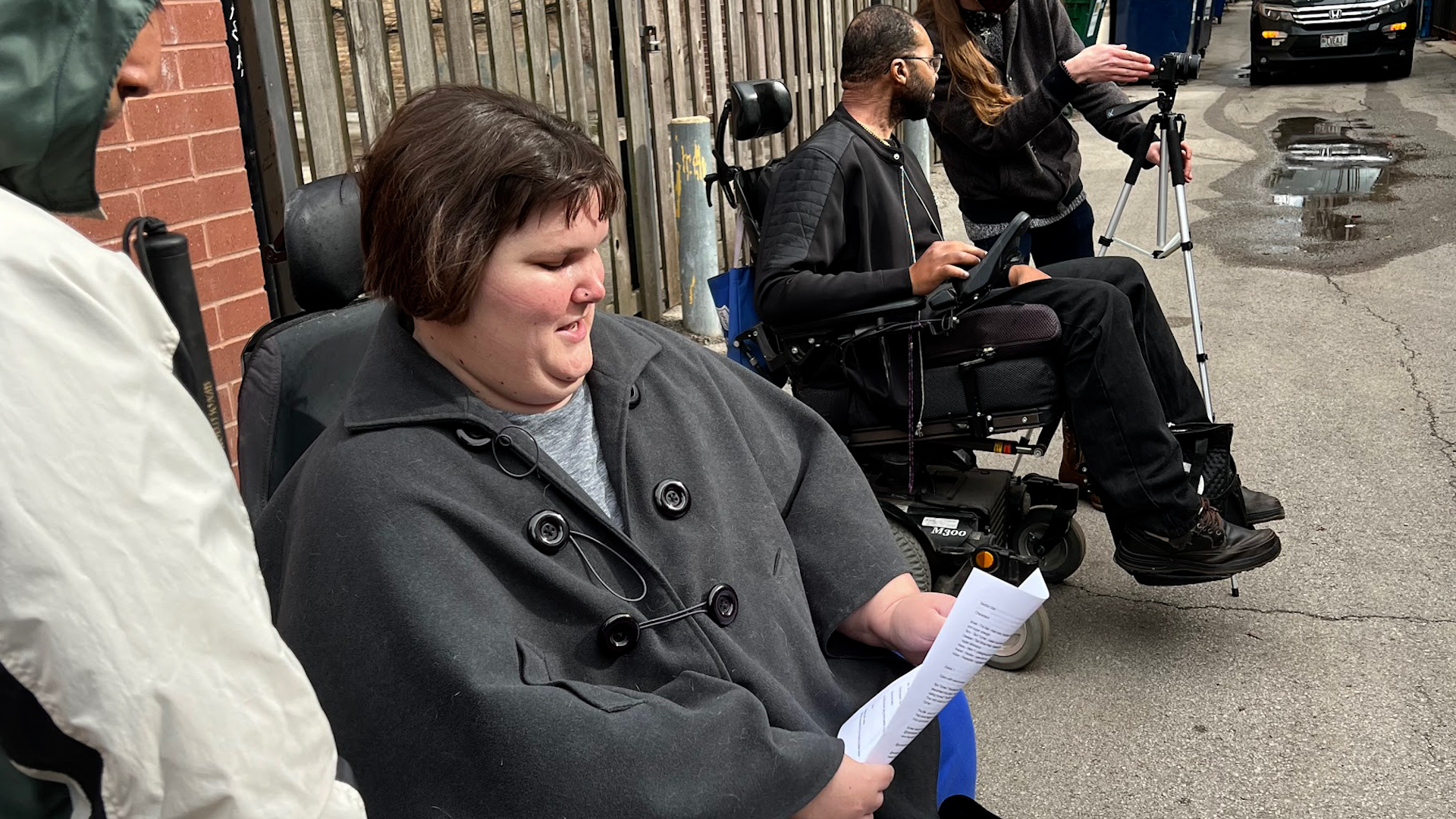 Crip Crap filming on location in Chicago
Crip Crap filming on location in Chicago
Tommy Carroll: Music has been my social ticket in, in many ways. Growing up, I was very aware that people had preconceived notions, and just to get to an an actual guard-down, human-on-human interaction, free of preconceptions, is very hard. Playing music felt like it opened the door to real interactions, friendships, and relationships. I've just continued on this path, picking up more conceptual ideas along the way, but at its core, music is a way of creating better social spaces—for everyone.
Arlene Malinowski: So we've all participated in the 3Arts/Bodies of Work Residency and that's a customized program where Deaf and disabled artists can design projects that they're working on, to connect with other artists like we are today, scholars, and mentors. Can you tell me a little bit about what you got out of the program, Kennedy?
Kennedy Healy: I was working on a musical about in-home care systems in Illinois. The residency, I think, was beneficial in various ways, notably through mentorship and the opportunity to connect with musicians. Just being able to say that you've received a residency or that someone read this script and saw merit in it was immensely helpful. And I think connecting with other disabled artists in Chicago has opened up more opportunities for me.
Tommy Carroll: I think the best part for me was when I got to do a concert on the UIC campus (University of Illinois Chicago) with my band, Calculated Discomfort. I was just beginning to develop and experiment with these newer concepts that evolved from that experience, in a space deeply rooted in disability. Interacting with the students and having that positive exchange was super awesome for me.
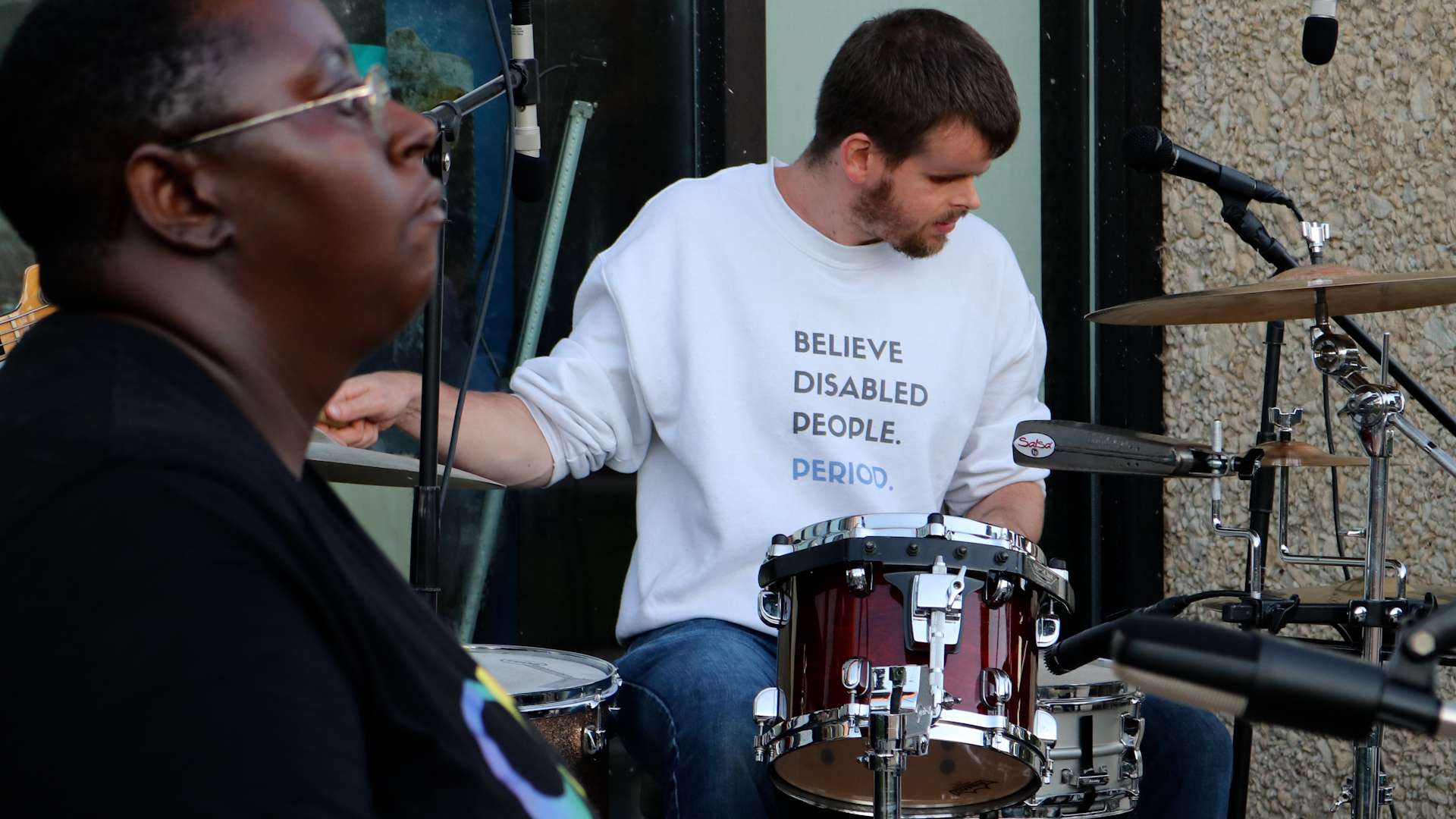 Crip Crap filming on location in Chicago
Crip Crap filming on location in Chicago
Arlene Malinowski: Tell me about Calculated Discomfort, I love the title, tell me about your band.
Tommy Carroll -- Calculated Discomfort on YouTubeTommy Carroll: The idea of Calculated Discomfort encompasses a lot of what I do now. It's not about making people uncomfortable. We're not trying to make people feel bad. It's about pursuing curiosity and putting different energies of people together. I play in rock bands, jazz bands, and more. So I invited like 10 to 15 people, and the goal of these compositions is to create different scenarios for people to interact in various ways. For instance, we're improvising but the main goal is to dance here, or we're improvising but the main goal is to as floaty as possible. But bring your own voice to it. Kind of just showing that there is inherently music in all these interactions. So I never know exactly what's coming, and that's what keeps it interesting.
Arlene Malinowski: Thanks! Kennedy, tell me about that musical.
Kennedy Healy: The musical follows eight main characters, four of them are disabled, and each has one care worker who also plays a central role. I started writing it before the pandemic, and was sort of inspired by romcoms like Love Actually, where all the characters are kind of connected but not.
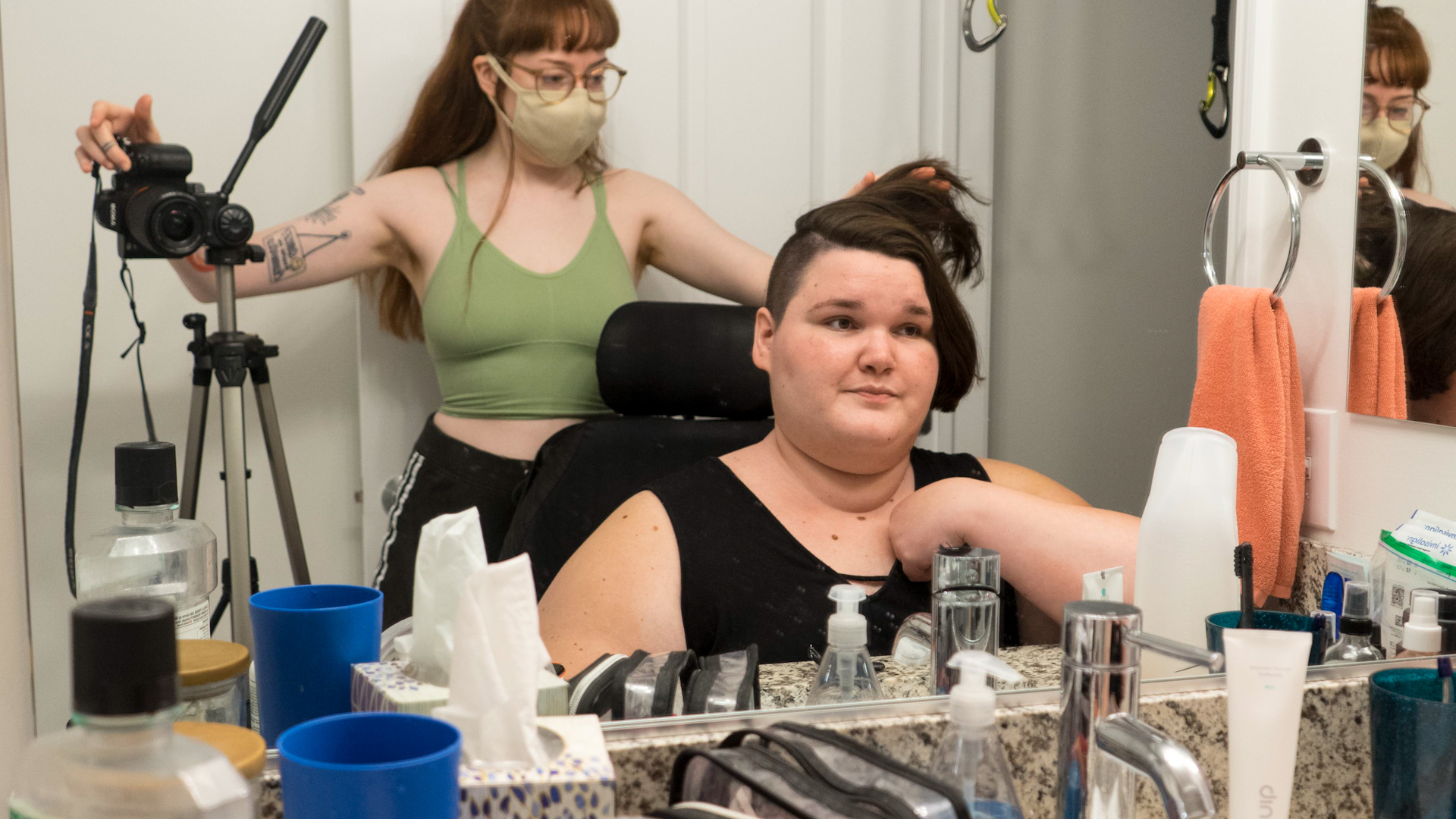 Care photo shoot, photo by Marley Molkentin
Care photo shoot, photo by Marley Molkentin
Kennedy Healy: And then Covid hit, and I was like ok I can't talk about care without talking about the pandemic. I've been inspired by Susan Nussbaum's Good Kings Bad Kings, as sort of a more modern critique of the in-home care systems, where she was writing about institutionalization. I did a reading and I had community members read the parts. And I had people write their own scenes about care. Because I think care is something that's very invisibilized, but it is like the fabric of a lot of society. So, just seeing that reflected in other people's scenes was really cool.
Arlene Malinowski: And a lot of it, as artists, is about the process. So, what form did that take for you, or how do you situate yourself within disability aesthetics?
Kennedy Healy: So, I think that was why I was drawn to a musical in the first place. I was like, our lives are ridiculous. Like, living under this system is ridiculous and needs to be put to song. There's no other way to cope with these realities than like through ridiculousness and humor. And I think, crip culture has used humor to resist desexualization and infantilization. So, I wondered how I could channel that into something that might help people see themselves, and affirm that reality, but also translate to other folks. I think changing perceptions is what can change systems.
Arlene Malinowski: And yes, breaking out into song at any time is perfect for any occasion.
Tommy Carroll: Seriously. Yeah, as Kennedy said, there's so much absurdity in the mentality of 'this is just how things are done.' But why? Things are so boxy. For me, I would hope that in some way, that my work evokes the sheer inventiveness and evolutionary capacity of the disability experience. We're always navigating one challenge or another, and that just creates much more surprising, much more innovative, interesting, stuff. Whether that's figuring out your personal care plan or celebrating a birthday, or coming up with a new piece of music for an ensemble of people who can and cannot see.
Arlene Malinowski: So what has been a benefit, or what has it meant to you to be part of the Disability Arts Community?
Kennedy Healy: So I moved to Chicago when I was 17, and I feel like I had a second raising here, like a political raising. So then to come up in the politics and find my creative flow and just have this hub here has been so helpful and beautiful.
Arlene Malinowski: And being around other people who may understand your work better and may raise the visibility of your work. I mean that's so unlike other places in the world right now for disability artists.
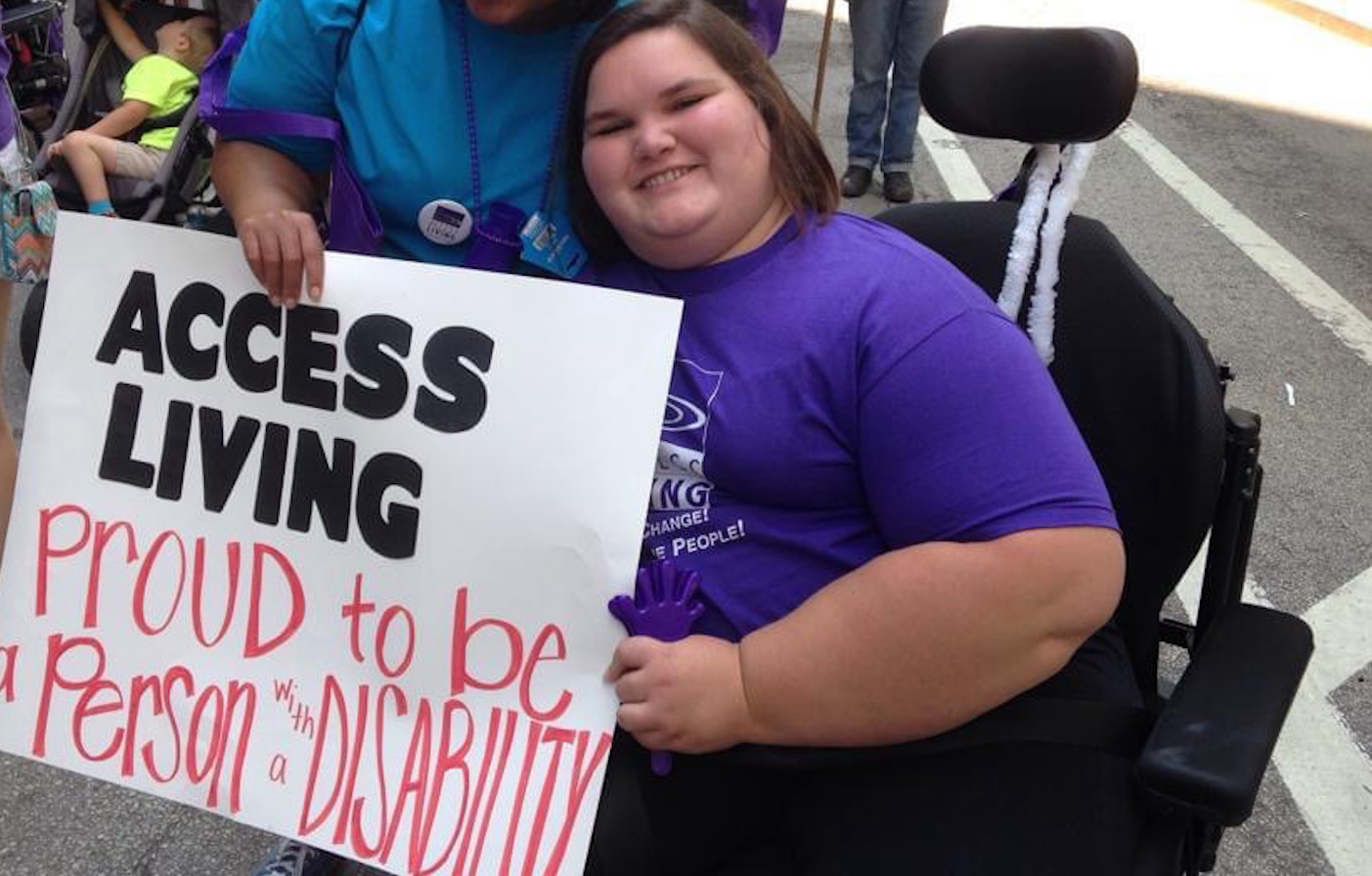 Disability Pride Parade
Disability Pride Parade
Tommy Carroll: I definitely think the biggest thing of my participation and being able to connect with others in the Chicago disability community has been slowly learning to embrace the sometimes roundabout or less efficient, you know, by mainstream standards, way of doing things as actual like assets and benefits.
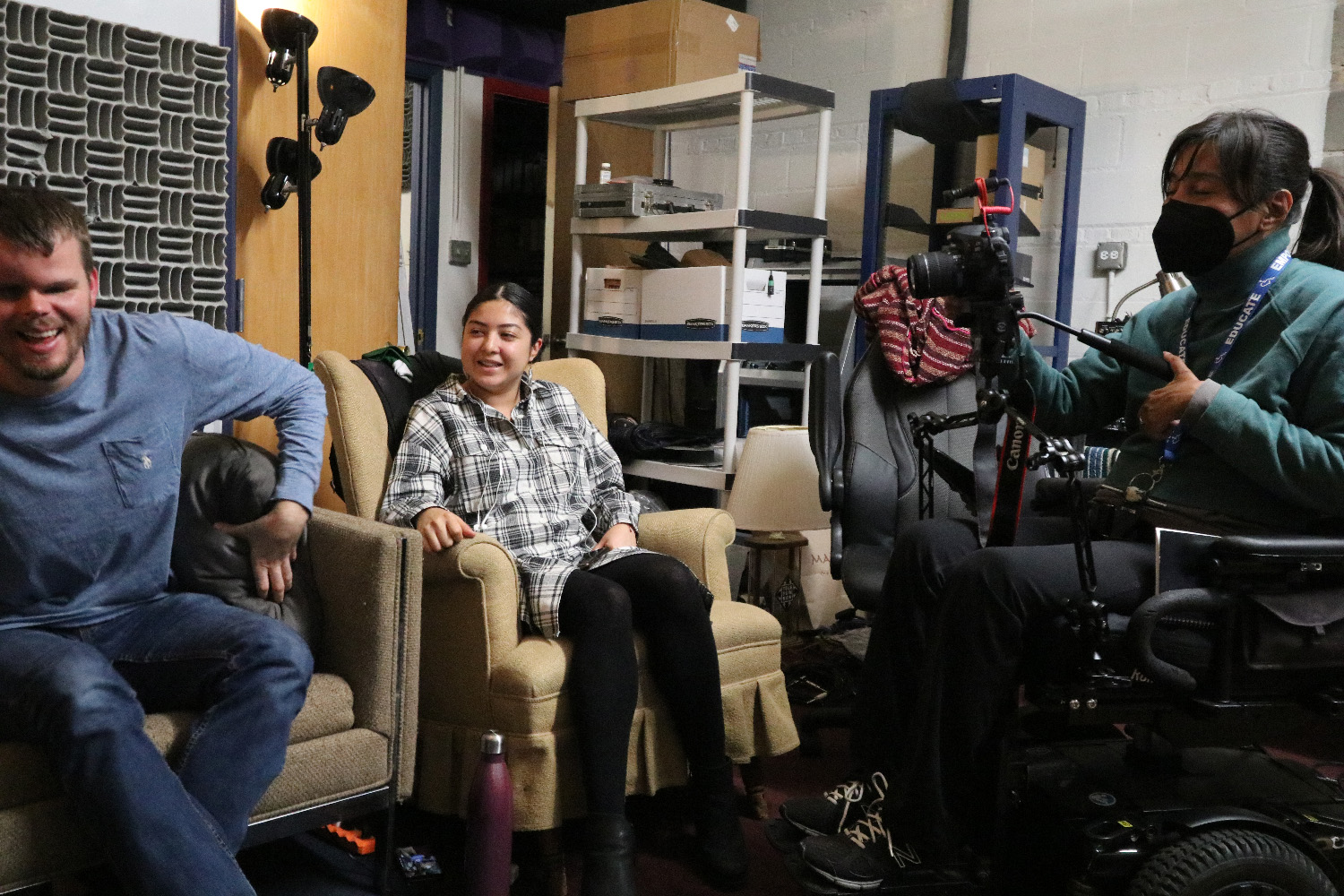 Tommy Carroll, Reveca Torres, and Stephanie Alma at Reel Sounds Studio Skokie
Tommy Carroll, Reveca Torres, and Stephanie Alma at Reel Sounds Studio Skokie
Tommy Carroll: Disability is like, it's really a reminder of humanity because we have people who have billions of dollars, you know, trying to optimize the humanity out of things. So disability, I feel proud to have this identity because people think that we're not human, but we're actually way more human.
Arlene Malinowski: I think being able to connect on a bunch of levels is really helpful to us as artists.
Tommy Carroll: It's a wide swath of ideas and thinking and stuff and you don't always get that.
Arlene Malinowski: Agreed! So think about your own career and what kinds of challenges did you face in gaining access or funding or training as an artist?
Kennedy Healy: You know, I've had two residencies that were both disability specific and I think what you're saying about like disabled people seeing disabled work, and like seeing it for what it is, when you approach other entities or just people not on the same page, you know. Your work might get called like unique, and it is but it isn't. Like, if you've read disabled playwrights who came before me, like there's themes in there.
Tommy Carroll: Structurally speaking, the music industry is ridiculously ableist. A lot of the music industry comes down to certain social assumptions. Like people don't even think to hire me because they don't even think that it'd be possible of me to bring my own drum set to a wedding venue or something like that. Not that I wanna be one of these cats who's out here playing weddings every weekend! But sometimes it would be nice if that was an option. The music industry; it's so visual in terms of production software, of how things are supposed to be marketed, and things like that. Having access to disability focused grants has allowed me to definitely make a lot more work than maybe I would been given the opportunity to do through traditional music industry outlets.
Kennedy Healy: I think people don't realize how much time artists spend like trying to get funding. And when you're disabled, you're also spending a ton of time like on care and health and transportation, housing, and all these just like regular life barriers. So to bust through all that and make it, in a world that's like still a little confused about disability, yeah, it's a feat.
Arlene Malinowski: I think what you said was so interesting and that is, uh, the business of the business as an artist, that is a whole entity unto itself. It's one thing to create, you know, and it's a whole another thing when it comes to how do you support yourself as an artist in the world.
Tommy Carroll: Not only are there different cultures of people who have disabilities, but within disability, it's so broad, like what it is and what that does. I guess I don't even know if this is a question or just kind of like a big ambiguous, philosophical softball. In what different types of ways do you find yourself thinking about the broadness of the disability spectrum?
Kennedy Healy: That was another helpful thing about Chicago. There is a lot of like cross disability movement work happening here, and the conversation has like really evolved, from like just like tacking a ramp on every building, which is really exciting if that's fitting for them. So just like meeting people where they're at, I think, can be really important in fostering cross disability community.
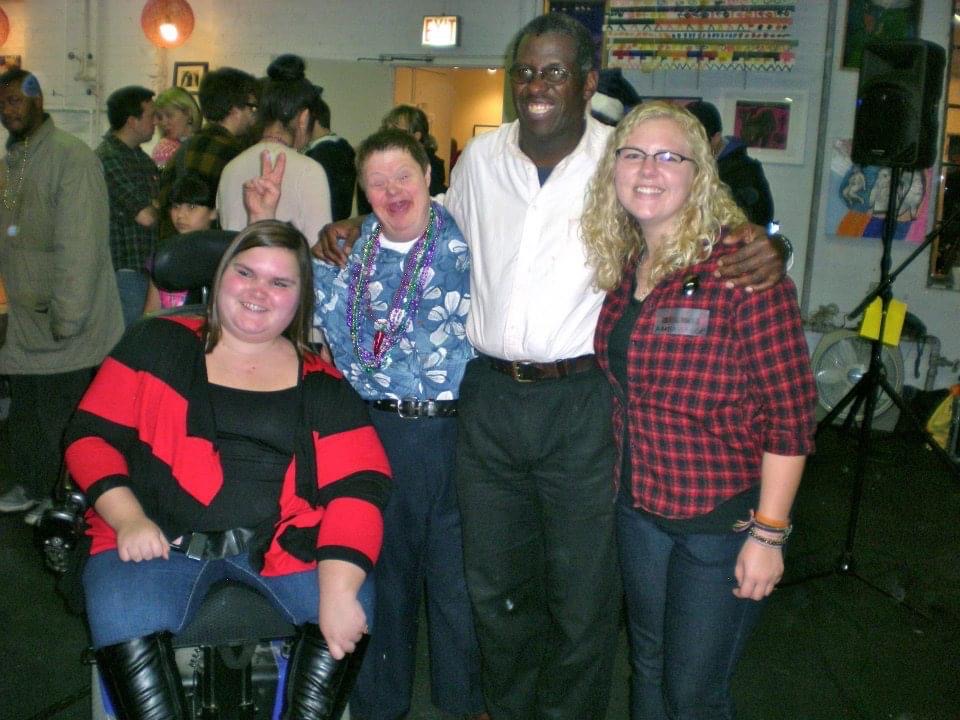 Arts of Life
Arts of Life
Tommy, I was going to ask you about sound being incorporated into other forms of art, like visual art, or like theater. I feel like audio description and just music in general are getting more baked in to other art forms and what you think about, like, is there a point where that impedes access or is it more enjoyable? Or do you find, like, the flowerly-ness of something like that to be annoying or like...?
Tommy Carroll: It's super context-dependent, for sure. Only in the past couple of years have I really had access to TV and movies. Now, with all the streaming platforms, they have the audio descriptions in there, which is awesome. However, I have a more complicated relationship with it. I have something coming up that addresses this. When it comes to visual art, like paintings and photography, there is a lot of work being done on image descriptions and things like that. But for me, having no recollection of any kind of sight, I'll be honest, I can struggle to engage with it. I will space out because that's not how I connect to the world.
Arlene Malinowski: You know the last couple of years have been hard on everyone, particularly artists because we're forced to create in vacuums, and then Covid separated us in so many ways. So, in the last four or five years, tell me an artistic win.
Tommy Carroll: I have to say, these past few years, artistically, have been very successful for me. I've been getting some institutional recognition, and just by not giving up, you know. I came out of Covid with ideas. I host one of the cooler jam sessions around town now. Just knowing that some moments are gonna be very successful and some moments will not. And I think part of it is just accepting who I am, and that's the biggest win you know, self-realization!
Arlene Malinowski: You're already at self-realization, which is just a little slightly ahead of me. Kennedy, what was your win?
Kennedy Healy: I started doing a lot more creative work because of the pandemic. Folding it in as a practice and like how to have an artistic process and like how to like really actually do it.
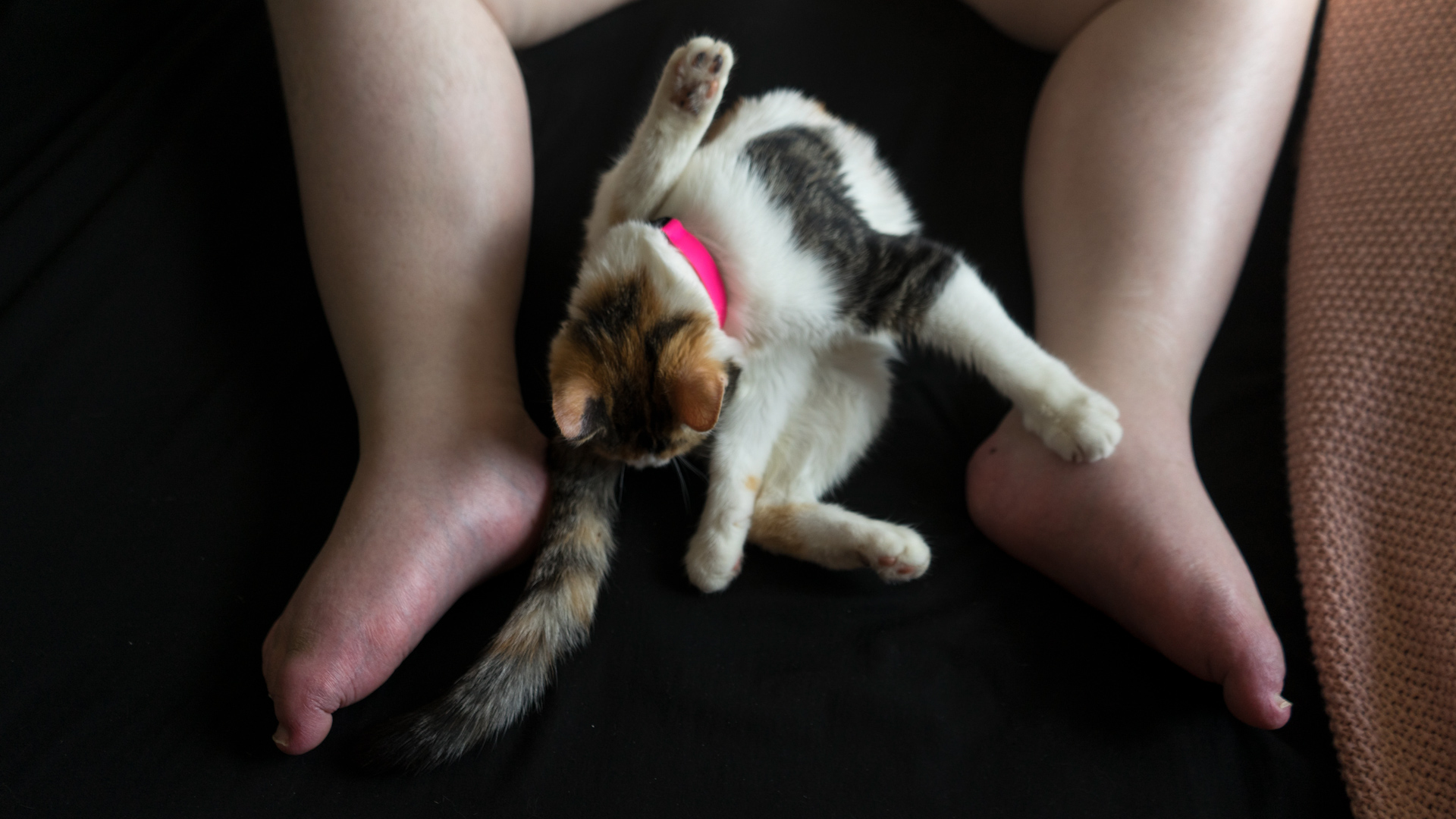 Care photo shoot, photo by Marley Molkentin
Care photo shoot, photo by Marley Molkentin
Arlene Malinowski: So what's coming up next for you as an artist, what do you dream about for your artistic life?
Kennedy Healy: So I'm working on the musical right now. I have a pilot for a show I wrote with a friend and working on a couple of children's books, and like wrapping some stuff up with a photo project. Crip Crap has a blog and a podcast, so I can't start any more projects right now, but trying to like gain traction in that field and consulting, I think, might be a nice way to like get my work out there and then like keep making new things.
Tommy Carroll: Man, I'm looking forward to just some consistency, like I think I'm finally at a point now where I'm running these jam sessions around the city. I feel that opens me up now where I do have a couple bigger scale creative ideas. Now that I just kind of feel like I really have my footing, I feel like I can do those things like even more.
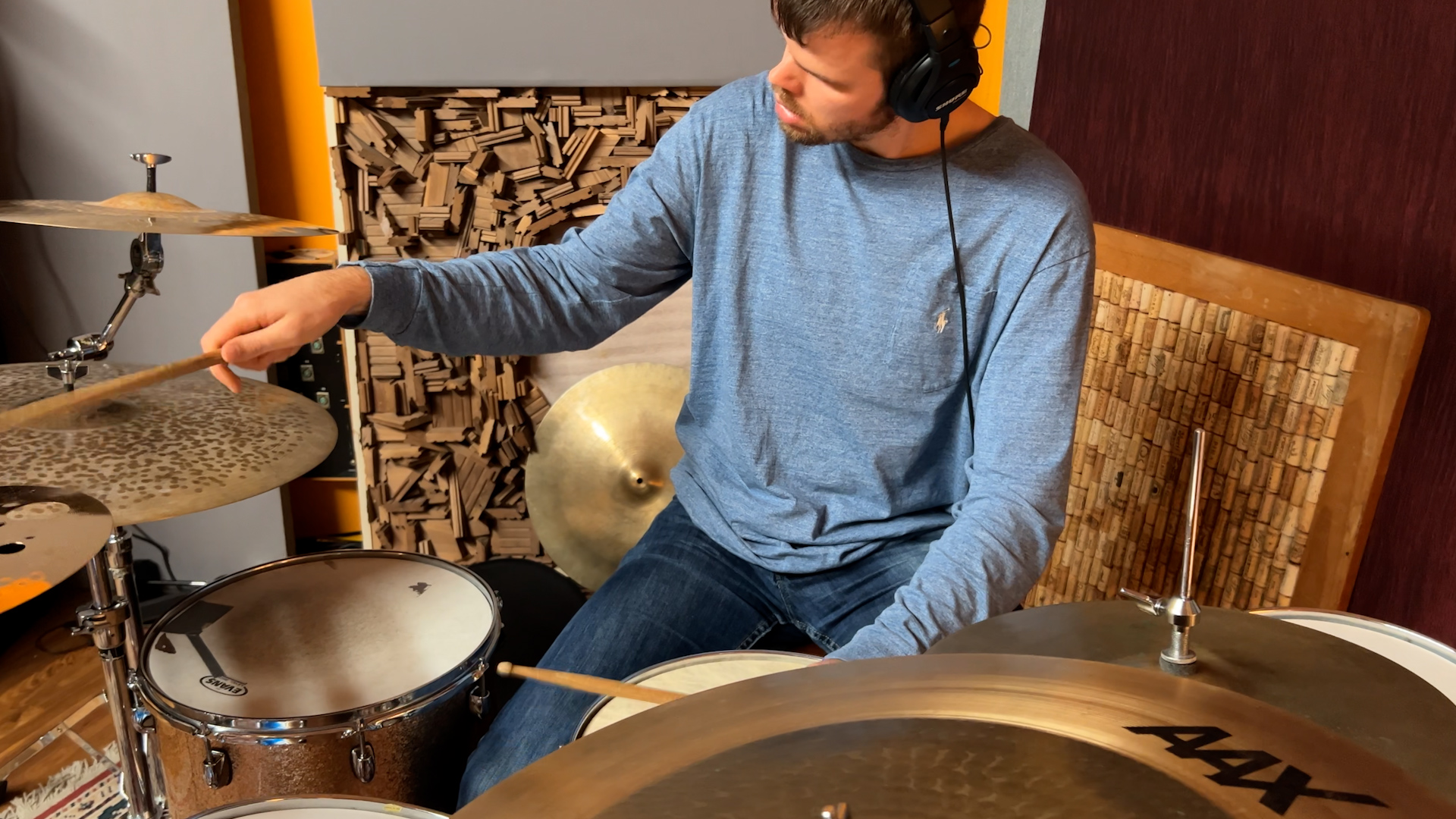 photo by Reveca Torres
photo by Reveca Torres
Arlene Malinowski: Another thing I wanted to ask is what do you hope to see for the future of the Disability Arts Movement?
Tommy Carroll: Get more and more equal chances to present all of our work, you know, in its fullest. Like I feel like I've been very lucky, just the chance to get our ideas out there more and more and it feel less and less less conditional, and also just the chance to really hopefully get to work with each other.
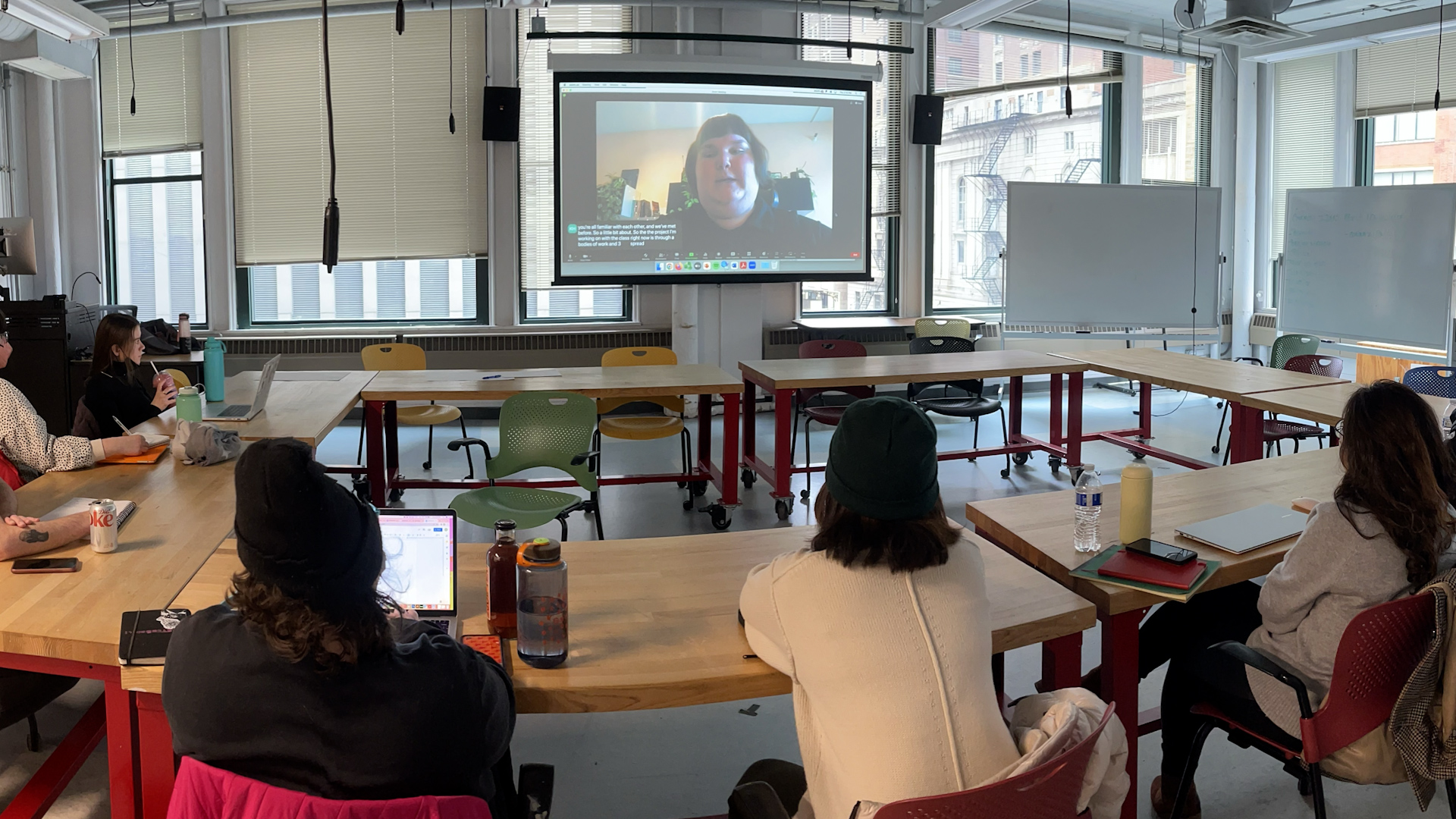 UIC classroom Presentation, photo by Sandie Yi
UIC classroom Presentation, photo by Sandie Yi
Arlene Malinowski: I like the idea of collaborating with artists within Disability Culture, there is a certain synergy that happens when we get together.
Kennedy Healy: I think all those things are sort of linked and cyclical, like it's not lost on me that like there were people creating these opportunities that I have now, like before there were curb cuts. Like, how?! But it still feels like, how are we doing this, you know, in the current climate. I think there's just so much power in like art and story. Yeah, I hope that it feeds that cycle.
Arlene Malinowski: Art and story. You know, that's the thing that survives societies and cultures, you know. Wars go away, politicians go away, but the art and the culture. That stays, that really does stay. I am so happy that we got a chance to do this and that I got to know not only your work but you as people. You are delightful and kind and generous, so thank you.
The Disability Culture Leadership Initiative and 3Arts/Bodies of Work Residency Program are supported in part by grants from
the Joyce Foundation and the National Endowment for the Arts.
